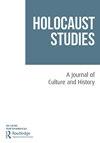Et in Ashkenazia ego: Utopias of the Holocaust?
IF 1
Q1 Arts and Humanities
引用次数: 0
Abstract
ABSTRACT This article interrogates examples of alternative histories in contemporary British Jewish writing which redraw and reinterpret the topography of the Holocaust. More specifically, it explores the tensions which arise in Clive Sinclair’s short story ‘Ashkenazia’ (1980) and Dan Jacobson’s novel The God-Fearer (1992) between notions of a Jewish heterotopia, the re-inscription of historical topographies, and the imaginary of the Holocaust. Set in an imaginary Jewish state, which is mapped onto the pre-existing Jewish topography of the loosely defined Ashkenaz of historical reality, both texts unfold alternative histories which, though imagined, nevertheless cannot un-think the historical occurrence of the Holocaust.等在阿什肯纳齐亚自我:大屠杀的乌托邦?
摘要本文探讨了当代英国犹太人写作中的另类历史的例子,这些历史重新描绘和解释了大屠杀的地形。更具体地说,它探讨了克莱夫·辛克莱(Clive Sinclair)的短篇小说《阿什肯纳齐亚》(Ashkenazia)(1980年)和丹·雅各布森(Dan Jacobson)的小说《上帝的恐惧者》(1992年)中出现的犹太异托邦概念、历史地形的重新铭文和大屠杀想象之间的紧张关系。这两部文本都以一个想象中的犹太国家为背景,映射到历史现实中定义松散的阿什肯纳兹的预先存在的犹太地形上,展开了另类历史,尽管这些历史是想象中的,但却无法想象大屠杀的历史发生。
本文章由计算机程序翻译,如有差异,请以英文原文为准。
求助全文
约1分钟内获得全文
求助全文

 求助内容:
求助内容: 应助结果提醒方式:
应助结果提醒方式:


